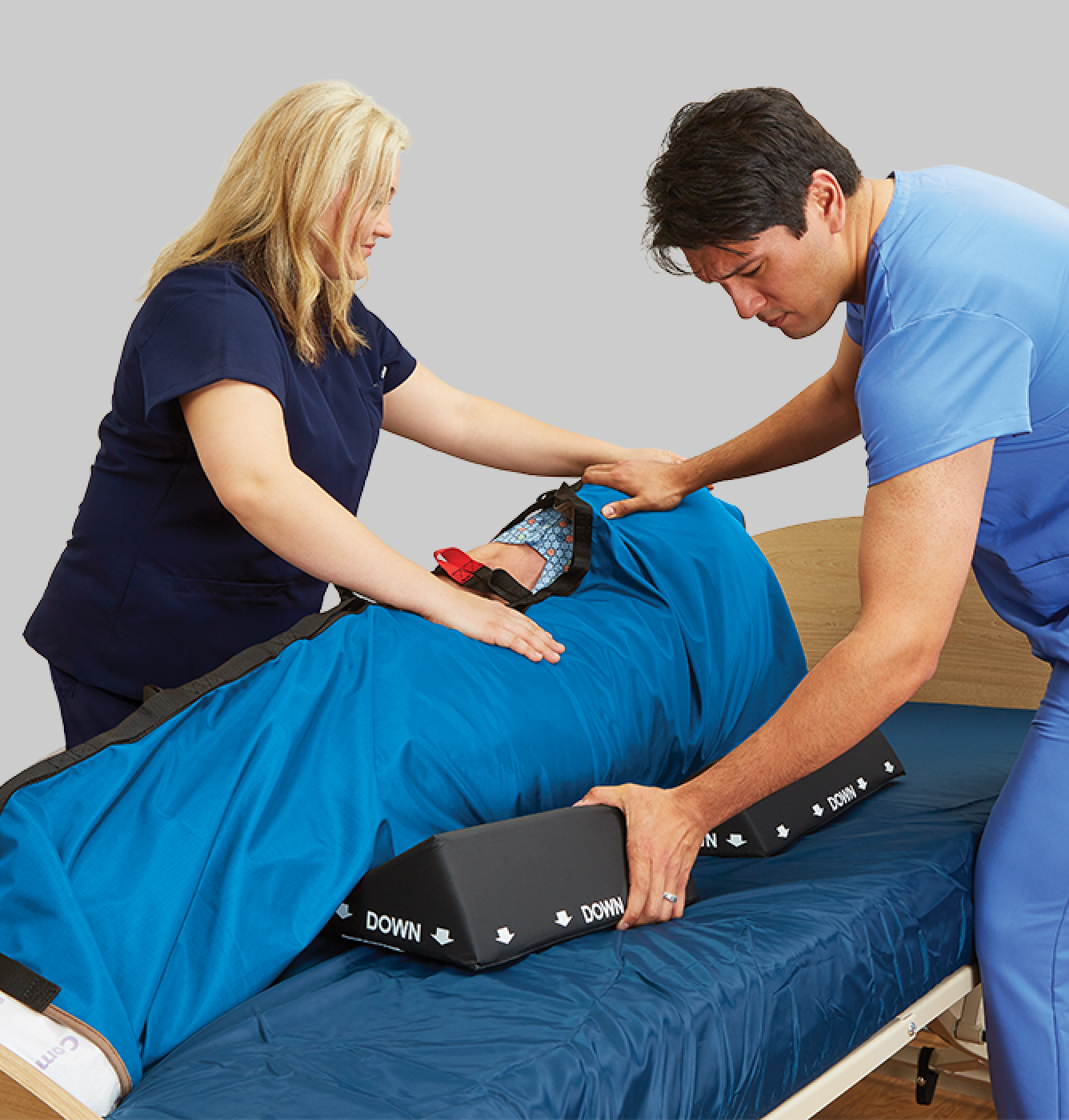Repositioning in the ICU

Work-related musculoskeletal disorders (MSDs) are a constant threat to healthcare workers. In 2017, the healthcare and social assistance industry reported more injury and illness cases than any other private sector1. The majority of these injuries are attributed to the manual handling of patients9. These injuries generally result from repetitive patient handling tasks such as lifting, repositioning and lateral transfers2,3. While the risk of injury is present for all front line health care providers, some care settings carry greater hazards than others.
ICU personnel have one of the highest rates of injury among all healthcare workers4
Intensive Care Unit personnel have one of the highest rates of injury among all healthcare workers4. The risk of injury is heightened in this arena due to the patient population’s high levels of dependency, need for assistive devices and possible positioning restrictions5. To protect ICU staff, it’s now recommended that facilities have a comprehensive safe patient handling program and accompanying product solutions—like our Uplift Solution (link to SPH page on the website). According to the Occupational Safety and Health Administration (OSHA), facilities should utilize safe patient handling equipment for all non-emergent lifting, repositioning and lateral transfer needs6. Patient lifts, friction-reducing devices, and air assist devices are three of the most commonly used product categories to meet OSHA’s recommendations11.
For lifting patients, the use of either ceiling or mobile lifts has been positively correlated with reduced MSD pain and injury4,8. Ceiling lifts have been shown to be one of the most versatile, safe patient handling tools available to providers7. In an ICU setting, ceiling lifts can be particularly helpful due to their close proximity and ease of use5.
Patient lifts, friction-reducing devices, and air assist devices are three of the most commonly used product categories to meet OSHA’s recommendations11
Repositioning patients in bed (boosting), laterally transferring and turning to offload patients have been shown to cause nearly twice as many MSDs as lifting10. This is particularly concerning for ICU staff members, as their patient population’s dependent nature equates to higher rates of repositioning tasks5. It’s recommended that facilities use friction-reducing devices for patients that can’t independently complete a boost or transfer12. Facilities are encouraged to also use air-assisted repositioning and lateral transfer devices for bariatric patients12.
For critically ill patients that cannot tolerate offloading due to hemodynamic instability, repositioning strategies should be implemented based on an individual’s tolerance.13
- Weight shifts
- Passive range of motion
- Position changes of the extremities
- Head rotation
- Heel floating
- Lower angle turns
Starting or maintaining a Safe Patient Handling initiative can be a daunting task. With the right mixture of investment, training and product-based solutions, we can care for those who care for everyone else. To learn more about the benefits of implementing Uplift at your facility, request a free discovery assessment.
Citations:
1. U.S.Bureau of Labor and Statistics. (2018). 2017 survey of occupational injuries & illness. Retrieved from https://www.bls.gov/iif/osch0062.pdf
2. Thomas DR, Thomas YL. Interventions to reduce injuries when transferring patients: a critical appraisal of reviews and a realist synthesis. Int J Nurs Stud. 2014;51(10)1381-1394.
3. Waters TR, Rockefeller K. Safe patient handling for re¬habilitation professionals. Rehabil Nurs. 2010;35(5):216-222.
4. Lee SJ, Faucett J, Gillen M, Krause N, Landry L. Factors associated with safe patient handling behaviors among critical care nurses. Am J of Ind Med. 2010;53:886-897.
5. Krupp, A., & Anderson, B. (2014). Standardized use of safe patient handling equipment in the ICU: a unit-based quality improvement project. Am J SPHM, 4(4), 122-128.
6. OSHA. (n.d.). Safe patient handling. Retrieved from https://www.osha.gov/Publications/OSHA3708.pdf
7. Association of Occupational Health professionals in Healthcare. (2014). A resource guide for implementing a safe patient handling program in the acute care setting. Retrieved from https://www.aohp.org/aohp/Portals/0/Documents/ToolsForYourWork/free_publications/Beyond%20Getting%20Started%20Safe%20Patient%20Handling%20-%20May%202014.pdf.pdf
8. D’Arcy L, Sasai Y, Stearns C. Do assistive devices, training, and workload affect injury incidence? Prevention efforts by nursing homes and back injuries among nursing assistants. J Adv Nurs. 2011; 68(4):836-845.
9. Davis, K. G., & Kotowski, S. E. (2015). Prevalence of musculoskeletaldisorders for nurses in hospitals, long-term care facilities, and home health care. Human Factors: The Journal of the Human Factors and Ergonomics Society, 57, 754–792.
10. AON. (2018). Health care workers compensation barometer actuarial analysis. Retrieved https://www.aon.com/risk-services/thought-leadership/report-2018- health-care-barometer.Jsp
11. Alliance, A. O. (2014). Beyond getting started: A resource guide for implementing a safe patient handling program in the acute care setting.
12. Galinsky, T., Deter, L., Krieg, E., Feng, H. A., Battaglia, C., Bell, R., … & Shaw, S. (2020). Safe patient handling and mobility (SPHM) for increasingly bariatric patient populations: Factors related to caregivers’ self-reported pain and injury. Applied Ergonomics, 91, 103300.
13. Brindle, C. T., Malhotra, R., O’Rourke, S., Currie, L., Chadwik, D., Falls, P., … & Creehan, S. (2013). Turning and repositioning the critically ill patient with hemodynamic instability: A literature review and consensus recommendations. Journal of Wound Ostomy & Continence Nursing, 40(3), 254-267.